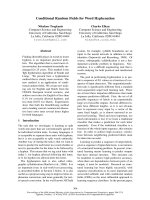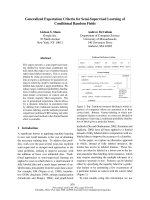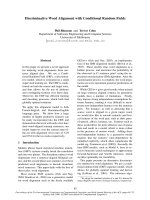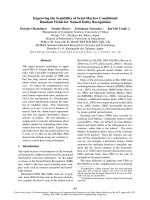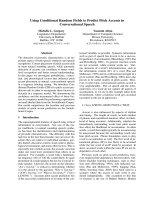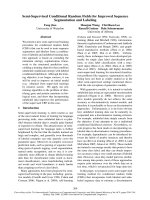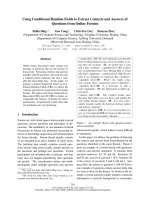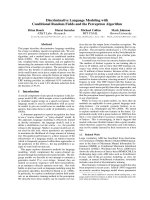hidden conditional random fields for gesture recognition
Bạn đang xem bản rút gọn của tài liệu. Xem và tải ngay bản đầy đủ của tài liệu tại đây (792.17 KB, 7 trang )
Hidden Conditional Random Fields for Gesture Recognition
Sy Bor Wang Ariadna Quattoni Louis-Philippe Morency David Demirdjian
Trevor Darrell
{sybor, ariadna, lmorency, demirdji, trevor}@csail.mit.edu
Computer Science and Artificial Intelligence Laboratory, MIT
32 Vassar Street, Cambridge, MA 02139, USA
Abstract
We introduce a discriminative hidden-state approach for
the recognition of huma n gestures. Gesture sequences of-
ten have a complex underlying structure, and models that
can incorporate hidden structures have proven to be ad-
vantageous for recognition tasks. Most existing approaches
to gesture recognition with hidden states employ a Hidden
Markov Model or suitable variant (e.g., a factored or cou-
pled state model) to model gesture streams; a significant
limitation of these models is the req uirement of conditional
indepen dence o f observations. In addition, hidden states
in a generative model are selected to maximize the like-
lihood of generating all the examples of a given gesture
class, which is not necessarily optimal for discriminating
the gesture class against other gestures. Previous discrim-
inative approaches to gesture sequence recognition h ave
shown promising results, but have not incorporated hidden
states nor addressed the problem of predicting the label of
an entire sequence. In this paper, we derive a discriminative
sequence model with a hidden state structure, and demon-
strate its utility both in a detection and in a multi-way clas-
sification formulation. We evaluate our method on the task
of recognizing human arm and head gestures, and compa re
the performance of our method to both generative hidden
state and discriminative fully-o bservable models.
1. Introduction
With the potential for many interactive applications, au-
tomatic gestu re recognition has been actively investigated
in the computer vision and pattern recognitio n community.
Head and arm gestures are often subtle, can happen at vari-
ous tim escales, and may exhibit long-rang e dependencie s.
All these issues make gesture recognition a challenging
problem.
One of the most common approaches for gesture r e cog-
nition is to use Hidden Markov Models (HMM) [19, 23], a
powerful generative model that includes hidden state struc-
ture. More gene rally, factored or coupled state models
have been developed, resulting in multi-stream dy namic
Bayesian networks [2 0, 3]. However, these gener a tive mod-
els assume that ob servations are conditionally independent.
This restriction makes it difficult or impo ssible to accom-
modate long-range dependencies among observations or
multiple overlapping features of the observations.
Conditional random fields (CRF) use an exponential dis-
tribution to model the entire sequence given the observation
sequence [10, 9, 21]. This avoids th e independence assump-
tion between observations, and allows non-local dependen-
cies b etween state and observations. A Markov assumption
may still be enfor ced in the state sequence , allowing infer-
ence to be performed efficiently using dynamic program -
ming. CRFs assign a label for each observation (e.g., each
time point in a sequ ence), an d th ey neither capture hidden
states nor directly provide a way to estimate the conditional
probability of a class label for an entire seque nce.
We propose a model for gesture recognition which incor-
porates hidden state variables in a discriminative multi-class
random field model, extendin g previous models for spatial
CRFs into the temporal domain. By allowing a classifica-
tion model with hidden states, no a-priori segmentation in to
substructures is needed, and labels at individual observa-
tions are optimally combined to form a class conditional
estimate.
Our hidden state conditional random field (HCRF)
model can be used either as a ge sture class detector, where
a single class is discriminatively trained against all other
gestures, or as a multi-way gesture classifier, where dis-
criminative models for m ultiple gestures are simultaneously
trained. The latter approach has the potential to share use-
ful hidden state structure s across the different classification
tasks, allowing higher recognition rates.
We have implemented HCRF-based methods for arm and
head gesture recognition and compared their performance
against both HMMs a nd fully observable CRF techniques.
1
In the remainder of this paper we review related work, de-
scribe our HCRF model, and then present a compara tive
evaluation of different models.
2. Related Work
There is extensive literature dedicated to gesture recog-
nition. Here we review th e methods most relevant to our
work. For hand and arm gestures, a compreh ensive sur-
vey was presented by Pavlovic et al. [16]. Generative mod-
els, like HMMs [19], and many extensions have been used
successfully to recognize arm gestures [3] and a number
of sign languages [2, 22]. Kapoor and Picard pre sented
a HMM-based, real tim e head nod and head shake detec-
tor [8]. Fugie et al. also used HMMs to perform head nod
recogn ition [6].
Apart from generative models, discriminative models
have been used to solve sequ e nce labeling proble ms. In the
speech and natural language processing community, Max-
imum Entropy Markov models (MEMMs) [11] have bee n
used for tasks such as word recognition, pa rt-of-speech tag-
ging, text segmentation and information extraction. The ad-
vantages of MEMMs are that they can model arbitrary fea-
tures of observation sequences and can therefore accommo-
date overlapping features.
CRFs were first introduced by Lafferty et al. [ 10] and
have be e n widely used since then in the natural language
processing community for tasks such as noun coreference
resolution [13], name entity recognition [12] and informa-
tion extraction [4].
Recently, there has been increasing interest in using
CRFs in the vision community. Sminchisescu et al. [21]
applied CRFs to classify human motion activities (i.e. walk-
ing, jumping, etc); their model can also discriminate subtle
motion styles like normal walk and wander walk. Kumar et
al. [9] used a CRF model for the task of image region label-
ing. Torralba et al. [24] introduced Boosted Random Fields,
a model that combines local and global image information
for contextua l object recognition.
Hidden-state conditional models have been applied suc-
cessfully in b oth the vision and speech community. In the
vision commu nity, Quattoni [18] applied HCRFs to model
spatial dep e ndencies for object rec ognition in unsegmented
cluttered images. In the speech community, it was applied
to phone classification [7] and the equivalence of HMM
models to a subset of CRF models was established. Here
we extend and demonstrate HCRF’s app lica bility to model
temporal sequences for gestu re reco gnition.
3. HCRFs: A Review
We will review HCRFs as described in [18]. We wish
to learn a mapping of ob servations x to class labels y ∈
Y, where x is a vector of m loc al observations, x =
{x
1
, x
2
, . . . x
m
}, and each local observation x
j
is repre-
sented b y a feature vector φ(x
j
) ∈ ℜ
d
.
An HCRF models the conditional probability of a class
label given a set of observations by:
P (y | x, θ) =
s
P (y, s | x, θ) =
s
e
Ψ(y,s,x;θ )
y
′
∈Y,s∈S
m
e
Ψ(y
′
,s,x;θ)
(1)
where s = {s
1
, s
2
, , s
m
}, each s
i
∈ S captures certain
underlying structure of each class and S is the set of hidden
states in the model. If we assume tha t s is observed and
that ther e is a single class label y then the conditional prob-
ability of s given x becomes a regular CRF. The potential
function Ψ(y, s, x; θ) ∈ ℜ, parameterized by θ, measures
the compatibility between a label, a set of observations and
a configuration of the hidden states.
Following previous work on CRFs [9, 10], we use the
following objective function in training the parameter s:
L(θ) =
n
i=1
log P (y
i
| x
i
, θ) −
1
2σ
2
||θ||
2
(2)
where n is the total number of training sequences. The first
term in Eq. 2 is the log-likeliho od of the data; the second
term is the log of a Ga ussian prior with variance σ
2
, i.e.,
P (θ) ∼ exp
1
2σ
2
||θ||
2
. We use gradient ascent to search
for the optimal parameter values, θ
∗
= arg max
θ
L(θ).
For our experim ents we used a Quasi-Newton optimization
technique [1] .
4. HCRFs for Gesture Recognition
HCRFs—discriminative models that contain hidden
states—are well-suited to the problem of gesture recogni-
tion. Quattoni [18] developed a discriminative hidden state
approa c h where the underlying graphical model captured
spatial dependencies between h idden object parts. In this
work, we modify the original HCRF approach to model
sequences where the underlyin g graphical model captures
temporal dependencies across frames, and to inc orporate
long ran ge dependencies.
Our goal is to distinguish between different gesture
classes. To achieve this goal, we learn a state distribution
among the different gesture c lasses in a d iscr iminative man-
ner. Generative models can require a considerable number
of observations for c ertain gestures classes. In additio n,
generative models may not learn a shared common structure
among gesture classes nor uncover the distinctive configu-
ration that sets one gesture class uniquely against others.
For example, the flip-back gesture used in the arm gesture
experiments (see Figure 1) c onsists of four parts: 1) lift-
ing one arm up, 2) lifting the other arm up, 3) crossing one
arm over the other and 4) returning both arms to their start-
ing position. We could use the fact that when we observe
the joints in a particular configuration (see FB illustration
in Figure 1) we can pr e dict with certainty the flip-back ges-
ture. Therefore, we would expect that this g esture would
be easier to learn w ith a discriminative model. We would
also like a model that incorporates long range depend encies
(i.e., that the state at tim e t can depend on observations that
happened earlier or later in the sequence.) An HCRF ca n
learn a discriminative state distribution and can be easily
extended to incorporate long ra nge d ependen cies.
To incorp orate long range dependencies, we modify the
potential function Ψ in Equation 1 to include a window pa-
rameter ω that defines the amount of past and future h is-
tory to be u sed when predicting the state at time t. Here,
Ψ(y, s, x; θ, ω) ∈ ℜ is defined as a potential function pa-
rameterized by θ and ω.
Ψ(y, s, x; θ, ω) =
n
j=1
ϕ(x, j, ω) · θ
s
[s
j
] +
n
j=1
θ
y
[y, s
j
]
+
(j,k)∈E
θ
e
[y, s
j
, s
k
] (3)
The graph E is a chain where each node corresponds to a
hidden state variable at time t; ϕ(x, j, ω) is a vector that can
include any feature of the observation sequence for a spe-
cific window size ω. (i.e. for window size ω, observations
from t − ω to t + ω are used to compute the features.)
The p arameter vector θ is made up of three components:
θ = [θ
e
θ
y
θ
s
]. We use the notatio n θ
s
[s
j
] to refer to the
parameters θ
s
that correspond to state s
j
∈
S
. Similarly,
θ
y
[y, s
j
] stands for parameters that correspond to class y
and state s
j
and θ
e
[y, s
j
, s
k
] refers to parameters that corre-
spond to class y and the pair of states s
j
and s
k
.
The inner product ϕ(x, j, ω) · θ
s
[s
j
] can be interpreted
as a measure of the compatibility between the observation
sequence and the state at time j at window size ω. Each pa-
rameter θ
y
[y, s
j
] can be interpreted as a measure of the com-
patibility between a hidden state k and a gesture y. Finally,
each parameter θ
e
[y, s
j
, s
k
] measures the compatibility be-
tween pairs of consecutive states j and k and the gesture
y.
Given a new test sequence x, and parameter values θ
∗
learned from training examples, we will take th e label for
the sequ e nce to be:
arg max
y∈Y
P (y | x, ω, θ
∗
). (4)
Since E is a chain, there are exact methods for inf e rence
and parameter estimation as both the objective function and
its gradient can be written in terms of marginal distributions
over the hidden state variables. These distributions can be
computed using belief propagation [17].
5. Experiments
We conducted two sets of experiments comparing HMM,
CRF, and HCRF models on head gestur e and arm gesture
datasets. The evaluation metric that we used for all the ex-
periments was the percentage of sequences for which we
predicted the corr ect gesture label.
5.1. Datasets
Head Gesture Dataset: To collect a head gestu re
dataset, pose tracking was perfo rmed using an adaptive
view-based appearance model which captured the user-
specific appeara nce under different poses [14]. We used
the fast Fourier transform of the 3D angular velocities as
features for gesture reco gnition.
The head gesture dataset consisted of interactions be-
tween human participants and an embod ied agent [15]. A
total of 16 participants interacted with a robot, with e ach
interaction lasting between 2 to 5 minutes. Human partici-
pants were video recorded while interacting with the robot
to o btain ground truth. A total of 152 head nods, 11 head
shakes and 159 junk sequ ences were extracted based on
ground truth labels. The junk class had sequences that did
not contain any head nods or head shakes during the inter-
actions with the r obot. Half of the sequences were used for
training and the rest w ere used for testing. For the expe r-
iments, we separated the data such that the testing da taset
had no participants from the training set.
Arm Gesture Dataset: We defined six arm gestures for
the experiments (see Figure 1). In the Expand Ho rizontally
(EH) arm gesture, the user starts with both arms close to th e
hips, moves both arms laterally apart and retracts back to the
resting position. In th e Expand Vertically (EV) arm g e sture,
the arms move vertically apar t and return to the resting posi-
tion. In the Shrink Vertically (SV) gesture, both arms begin
from the hips, move vertically together and back to the hips.
In the Point and Back (PB) gesture, the user points with one
hand and beckons with the other. In the Do uble Back (DB)
gesture, both arms beckon towards the u ser. Lastly, in the
Flip Back (FB) gesture, the user simulates ho lding a b ook
with one hand while the o ther hand makes a flipping mo-
tion, to mimic flipping the pages of the book.
Users were asked to perfor m these gestures in front of
a stereo camera. From each image frame, a 3D cylindrical
body m odel, consisting of a head, torso, arms and forearms
was estimated using a ster e o-tracking algorithm [5]. Figure
5 shows a gesture sequence with the estima te d body model
superimposed on the user. From these body models, both
the joint angles and the relative co -ordinates of the joints
of the arms are used as observations for our experiments
and were manually segmented into six arm gesture classes.
Thirteen users were asked to perfor m these six gestures; an
average of 90 gestures per class were collected.
Figure 1. Illustrations of the six gesture classes for the experiments. Below each image is the abbreviation for the gesture class. These
gesture classes are: FB - Flip Back, SV - Shrink Vertically, EV - Expand Vertically, DB - Double Back, PB - Point and Back, EH - Expand
Horizontally. The green arrows are the motion trajectory of the fi ngertip and the numbers next to the arrows symbolize the order of these
arrows.
5.2. Models
Figures 2, 3 and 4 show graphical representations of the
HMM model, the CRF model, and the HCRF (multi- c la ss)
model used in our experiments.
HMM Model - As a first baseline, we trained a HMM
model per class. Each model had four states and used a
single Gaussian observation model. During evaluation, test
sequences were passed thr ough each of these models, and
the model with the highest likelihood was selected as the
recogn ized gesture.
CRF Model - As a second baseline, we traine d a sin-
gle CRF chain model where every gesture class had a corre-
sponding state. In this case, the CRF predicts labels for each
frame in a sequence, not the entire sequence. During evalu-
ation, we found the Viterbi path under the CRF model, and
assigned the sequence label based on the most frequently
occurring gesture label per frame. We ran additional exper-
iments that incorporated different long range dependencies
(i.e. using different window sizes ω, as described in Section
4).
HCRF (one-vs-all) Model - For each gesture class, we
trained a separate HCRF model to discriminate the gesture
class from other classes. Each HCRF was traine d using six
hidden states. For a given test sequence, we compared the
probabilities for each single HCRF, a nd the highest scoring
HCRF model is selected as the recognized gesture.
HCRF (multi-class) Model - We trained a sin gle HCRF
using twelve hidden states. Test sequenc e s were run with
this model and the gesture class with the highest probability
was selected as the recognized gesture. We also condu c te d
experiments that incorporated different long range depen-
dencies in the same way as described in the CRF experi-
ments.
For the HMM model, the number of Gaussian mixtures
and states were set by minimizing the error on train ing data,
and for hidden state models the number of hidden states was
Models Accuracy (%)
HMM ω = 0 65.33
CRF ω = 0 66.53
CRF ω = 1 68.24
HCRF (multi-class) ω = 0 71.88
HCRF (multi-class) ω = 1 85.25
Table 1. Comparisons of recognition performance (percentage ac-
curacy) for head gestures.
set in a similar fashion.
6. Results and Discussion
For the training process, the CRF models for the arm and
head gesture dataset took about 200 iterations to train. The
HCRF models fo r the arm and head gesture dataset req uired
300 and 400 iterations for training respectively.
Table 1 summarize s the re sults for the head gesture ex-
periments. The multi-class HCRF model performs better
than the HMM and CRF mo dels at a window size of zero.
The CRF has slightly better performan ce than th e HMMs
for the head gesture task, and this performance improved
with increased window sizes. The HCRF multi-class model
made a significant improvement when the window size was
increased, which indicates that incorporating long range de-
pendencies was useful.
Table 2 summarizes results for the arm gesture recogni-
tion experiments. In these experiments the CRF performed
better than HMMs at window size z ero. At window size
one, however, the CRF performance was poorer; this may
be due to overfitting when training the CRF mode l parame-
ters. Both multi-class and one-vs-all HCRFs perform better
than HMMs and CRFs. The most significant improvement
in perform ance was obtained when we used a multi-class
HCRF, suggesting that it is important to jointly learn the
best discriminative structure.
Figure 5. Sample image sequence with the estimated body pose superimposed on the user in each frame.
Figure 2. HMM model
Figure 3. CRF Model
Figure 4. HCRF Model
Figure 6 shows the distribution o f states for different ges-
ture classes learned by the best performing model (multi-
class HCRF). This graph was obtained by compu ting the
Viterbi path for each sequence (i.e. the most likely assign-
Models Accuracy (%)
HMM ω = 0 84.22
CRF ω = 0 86.03
CRF ω = 1 81.75
HCRF (one-vs-a ll) ω = 0 87.49
HCRF (multi-class) ω = 0 91.64
HCRF (multi-class) ω = 1 93.81
Table 2. Comparisons of recognition performance (percentage ac-
curacy) for body poses estimated from image sequences.
12
9
12
9
4
6
4
9
4
6
1
9
10
4
9
EH
EV
PB
DB
FB
SV
Figure 6. Graph showing the distribution of the hidden states for
each gesture class. The numbers in each pie represent the hidden
state label, and the area enclosed by the number represents the
proportion.
ment for the hidden state variables) and counting the num-
ber of times that a given state occurred among those se-
quences. As we can see, the model has found a unique
distribution of hidden states for each gesture , and there is
a significant amoun t of state sharing a mong different ges-
ture classes. The state assignment for each image frame
of various gesture classes is illustrated in Figure 7. Here,
we see that body poses that are visually more unique for a
gesture c la ss are assigned very distinct hidden states, while
body poses common between different gesture classes are
assigned the same states. For example, frames of the FB
Models Accuracy (%)
HCRF ω = 0 86.44
HCRF ω = 1 96.81
HCRF ω = 2 97.75
Table 3. Experiment on 3 arm gesture classes using the multi-class
HCRF with different window sizes. The 3 different gesture classes
are: EV-Expand Vertically, SV Shrink Vertically and FB - Flip
Back. The gesture recognition accuracy increases as more long
range dependencies are incorporated.
gesture are uniq uely assigned a state of one while the SV
and DB gesture class have visibly similar frames that share
the hidden state fo ur.
The arm gesture results with varying window sizes are
shown in Table 3. From these results, it is clear that incor-
porating some amount of contextual dependency is impor-
tant, since the HCRF performance improved with increas-
ing window size.
7. Conclusion
In this work we presented a discriminative hidden-state
approa c h fo r g e sture recognition. Our pro posed mod el
combines the two main advantages of current approaches to
gesture recognition: the a bility o f CRFs to use long ran ge
dependencies, and the ability of HMMs to model latent
structure. By regarding the sequence label as a random vari-
able we can train a single joint model for all the gestur e s and
share hidden states between them. Our results have shown
that HCRFs outp erform both CRFs and HMMs for certain
gesture recognition tasks. For arm gestures, the multi-class
HCRF model outperforms HMMs and CRFs even when
long range dependencies are not used, demonstrating the
advantages of joint discriminative learning.
References
[1] Quasi-newton optimization toolbox in matlab.
[2] M. Assan and K. Groebel. Video-based sign language recog-
nition using hidden markov models. I n Int’l Gest Wksp:
Gest. and Sign Lang., 1997.
[3] M. Br and, N. Oliver, and A. Pentland. Coupled hidden
markov models for complex action recognition. In CVPR,
1996.
[4] A. Culotta and P. V. amd A. Callum. Interactive informa-
tion extraction wit h constrained conditional random fields.
In AAAI, 2004.
[5] D. Demirdjian and T. Darrell. 3-d articulated pose tracking
for untethered deictic reference. In Int’l Conf. on Multimodal
Interfaces, 2002.
[6] S. Fujie, Y. Ejiri, K. Nakajima, Y. Matsusaka, and
T. Kobayashi. A conversation robot using head gesture
recognition as para-linguistic i nformation. In Proceedings
of 13th IEEE International Workshop on Robot and Human
Figure 7. Articulation of the six gesture classes. The first few con-
secutive frames of each gesture class are displayed. Below each
frame is the corresponding hidden state assigned by the multi-class
HCRF model.
Communication, RO-MAN 2004, pages 159–164, September
2004.
[7] A. Gunawardana, M. Mahajan, A. Acero, and J. C. Platt.
Hidden conditional random fields for phone classification.
In INTERSPEECH, 2005.
[8] A. Kapoor and R. Picard. A real-time head nod and shake
detector. In Proceedings from the Workshop on Perspective
User Interfaces, November 2001.
[9] S. Kumar and M. Herbert. Discriminative random fields:
A framework for contextual interaction in classification. In
ICCV, 2003.
[10] J. Lafferty, A. McCallum, and F. Pereira. Conditional ran-
dom fields: probabilistic models for segmenting and la-
belling sequence data. In ICML, 2001.
[11] A. McCallum, D. Freitag, and F. Pereira. Maximum entropy
markov models for information extraction and segmentation.
In ICML, 2000.
[12] A. McCallum and W. Li. Early results for named entity
recognition with conditional random fields, feature induction
and web-enhanced lexicons. In CoNLL, 2003.
[13] A. McCallum and B. Wellner. Toward conditional models of
identity uncertainty with application to proper noun corefer-
ence. In IJCAI Workshop on Information Integration on the
Web, 2003.
[14] L P. Morency, A. Rahimi, and T. Darrel l. Adaptive view-
based appearance model. In CVPR, 2003.
[15] L P. Morency, C. Sidner, C. Lee, and T. Darrell. Contextual
recognition of head gestures. In ICMI, 2005.
[16] V. I. Pavlovic, R. Sharma, and T. S. Huang. Visual interpre-
tation of hand gestures for human-computer interaction. In
PAMI, volume 19, pages 677–695, 1997.
[17] J. Pearl. Probabilistic Reasoning in Intelligent Systems: Net-
works of Plausible Inference. Morgan Kaufmann, 1988.
[18] A. Quattoni, M. Collins, and T. Darrell. Conditional random
fields for object recognition. In NIPS, 2004.
[19] L. R. Rabiner. A tutorial on hidden markov models and se-
lected applications in speech recognition. In Proc. of the
IEEE, volume 77, pages 257–286, 2002.
[20] K. Saenko, K. Livescu, M. Siracusa, K. Wilson, J. Glass, and
T. Darrell. Visual speech recognition with loosely synchro-
nized feature streams. In ICCV, 2005.
[21] C. Sminchisescu, A . Kanaujia, Z. Li, and D. Metaxas. Con-
ditional models for contextual human motion recognition. In
Int’l Conf. on Computer Vision, 2005.
[22] T. Starner and A. Pentland. Real-time asl recognition from
video using hidden markov models. In ISCV, 1995.
[23] T. Starner and A. Pentland. Visual recognition of american
sign language using hidden markov models. In Int’l Wkshp
on Automatic Face and Gesture Recognition, 1995.
[24] A. Torralba, K. Murphy, and W. Freeman. C ontextual models
for object detection using boosted random fields. In NIPS,
2004.
